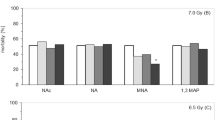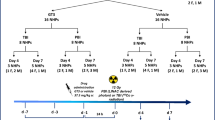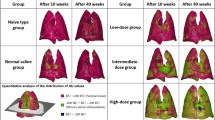Abstract
AMINOETHYLISOTHIOURONIUM bromide·hydrobromide (AET) and hypoxia appear to act as radiation dose reducers; that is, to obtain the same biological response to radiation, higher doses are required in the presence of these agents than in their absence. The ratio of the doses required to elicit the same response in the presence and in the absence of the protectant (protection ratio) is about the same for radiation-induced mortality, changes in the various elements of the haematopoietic system, and changes in spleen, thymus, and body-weights1,2. The constancy of the protection ratio and recent cell culture studies3 imply that radiation injury produced under the two conditions is equivalent. Recent investigations in this laboratory, however, have suggested that the radiation injury may not be completely equivalent. In sheep, pentobarbital anaesthesia and assumed attendant hypoxia resulted in a mortality protection ratio of 1.4. However, recovery at 30 days as measured by the split-dose technique was significantly less in the anaesthetized group than in animals irradiated without anaesthesia4,5. The present experiments with AET and hypoxia were conducted to determine the influence of protectants on initial injury and recovery from this injury. The term ‘recovery’ is used here to indicate the gradual return to normal radiosensitivity following a sub-lethal dose.
This is a preview of subscription content, access via your institution
Access options
Subscribe to this journal
Receive 51 print issues and online access
$199.00 per year
only $3.90 per issue
Buy this article
- Purchase on Springer Link
- Instant access to full article PDF
Prices may be subject to local taxes which are calculated during checkout
Similar content being viewed by others
References
Doherty, D. G., in Radiation Protection and Recovery, edit. by Hollaender, A. (Pergamon Press, London, 1960).
Gray, L. H., Amer. J. Roentgenol., 85, 803 (1961).
Elkind, M. M., Alescio, T., Swain, R. W., Moses, W. B., and Sutton, H., Nature, 202, 1190 (1964).
Leong, G. F., Wisecup, W. G., and Grisham, J. W., Ann. N.Y. Acad. Sci., 114, 138 (1964).
Page, N. P., Nachtwey, D. S., Leong, G. F., Ainsworth, E. J., and Alpen, E. L., Radiat. Res., 25, 224 (1965).
Cudkowitz, G., Proc. Soc. Exp. Biol. and Med., 107, 821 (1961).
Andrews, J. R., Correa, J. N., and Belli, J. A., in Biological Effects of Neutron and Proton Irradiation (International Atomic Energy Agency, Vienna, 1964).
Alper, T., Physics in Med. Biol., 8, 365 (1963).
Barendsen, G. W., and Walter, H. M. D., Radiat. Res., 21, 314 (1964).
Revesz, L., and Littbrand, B., Nature, 203, 742 (1964).
Littbrand, B., and Revesz, L., Nature, 203, 889 (1964).
Author information
Authors and Affiliations
Rights and permissions
About this article
Cite this article
AINSWORTH, E., PHILLIPS, T. & KENDALL, K. Influence of Aminoethylisothiouronium Bromide·hydrobromide and Hypoxia on Recovery from Radiation Injury in Mice. Nature 210, 323–324 (1966). https://doi.org/10.1038/210323a0
Published:
Issue Date:
DOI: https://doi.org/10.1038/210323a0
This article is cited by
Comments
By submitting a comment you agree to abide by our Terms and Community Guidelines. If you find something abusive or that does not comply with our terms or guidelines please flag it as inappropriate.



